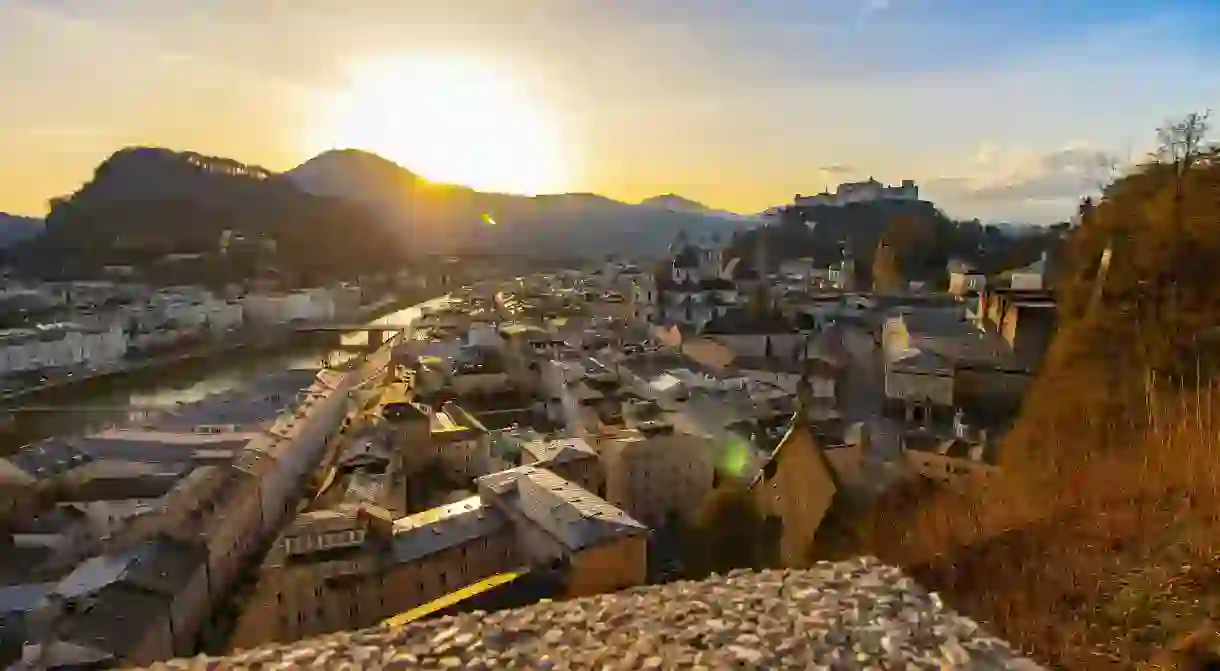14 Most Fun and Unusual Things to Do in Salzburg

Salzburg has a delightfully-wonderful blend of natural beauty and unique urban sites throughout the city that entice visitors and locals alike. From outdoor excursions to famous attractions, here are some of the many experiences that Salzburgians might wish to keep under wraps from visitors and tourists and enjoy for themselves.
Siemens Festspielnächte
Architectural Landmark

Taking place from July until August, this festival puts on daily showings of various concerts –including operas and theatre productions –on a large-scale screen. The films are screened onto a wall in Kapitelplatz (Chapter Square in English) – one of Salzburg’s most spacious and popular-public spaces to see a few of the city’s main sites such as the Cathedral and the city’s fortress. As well as the culture that’s on offer, the festival also offers a culinary feast with stalls serving hot- and cold-Austrian food.
St. Sebastian's Cemetery
Cemetery

Mozart's Skull
Architectural Landmark
The legitimacy of this creepy and strange artifact remains in dispute, but many avidly claim that the skull belongs to Salzburg’s own and one of the world’s most famous classical composers. Located at the University Mozarteum, the skull came into scientists’ possession in 1902. The skull, with an absent lower jaw, is said to match historical records. Legend has it that in 1801, gravedigger Joseph Rothmayer took the skull from the grave Mozart was buried ten years before. Albeit a morbid exhibition, it certainly provides a more unconventional day out than Mozart’s birthplace. Viewings have been closed to the wider public but remain available upon request.
The Jazzit
Music Venue
Ice Caves
Natural Feature

Venture out roughly an hour away from Salzburg to see the world’s largest Ice Caves in Werfen. An incredible structure is as imposing as it is impressive, this underground cavern of twisted organic sculptures have formed in a manner that appears deliberate. A completely unique spectacle to behold, it is open to the public between May and October. Guided lantern-lit tours take visitors through the steep, winding alleys and glistening walls and offer scientific and historical facts about the phenomena along the way. Be sure to wear warm clothing, whatever the weather.
Panorama Museum
Museum
St. Peter's Stiftskeller
Historical Landmark
Rumoured to be Central Europe’s oldest restaurant at 1200 years old, the Stiftkeller is built within the walls of St. Peter’s Abbey. Serving delicious meals made with locally-sourced ingredients such as freshly-caught trout and regional vegetables, it is not only one of the oldest but one of the best. The restaurant also offers a ‘Mozart dinner’ – an evening that transports patrons back to the 1700s with historical food served by candlelight and music performed by the graduates of the Mozarteum University-Salzburg.
Mozart's Birthplace
Memorial, Museum

Learn about the life and work of one of Austria’s most renowned resident and one of the most revered- and prolific-classical composers of all time. Mozart’s birthplace, in the picturesque Old Town, is one of the most frequently-visited tourist attractions in all of Austria and offers a glimpse into the prodigy’s early days with a collection of portraits, historical instruments, and various memorabilia from his lifetime.
Grünmarkt
Market
Translating to ‘green market’, this is Salzburg’s best place to pick up some local food in the city’s grandest square. Regional cheeses, hams, fruit, vegetables, and bread are all up for grabs – and there is the chance to pick up some tasters for free too. Held outside the university every day, be sure to try the gigantic pretzels.
Untersberg
Natural Feature

Imposing views of glittering lakes and jagged mountains stretching for miles on end, it’s understandable why the locals wish this natural-hot spot that straddles Germany and Austria was lesser known. There are a few ways to get up to the peak. Ambitious walkers can hike up to the top or people can take the Untersberg cable car up above the clouds in under 10 minutes.
Grosser Hafner
Natural Feature
Visitors can best see the staggering views of the jagged mountains and lush meadows surrounding the city up high – and hiking provides the best method of transportation in Salzburg. One of the most scenic – and ambitious – trails is the ‘Grosses Hafner.’ Definitely not intended for lighthearted hikers, this epic trek takes people across challenging terrain of steep climbs and rocky landscapes. For a more-forgiving route, try the ‘Salzburger Almenweg’, a romantic amble that takes hikers past waterfalls, chapels, and meadows.
Zwerglgarten
Architectural Landmark
Created by Prince Archbishop Franz Anton Harrach in 1715, the Zweglgarten is a large gathering of unsightly dwarves – an unusual tribute to the entertainers who performed for the monarch. The garden, located in the Mirabell Palace, contains a semi-circle of nine statues with a variety of intriguing expressions. Due to feelings that the monuments were too ugly, they were removed with plans to destroy them. Fortunately, (or unfortunately, depending on the person asked) they were reinstated by the Salzburg Society for the Preservation of Local Amenities in 1921.
Salzburger Seenland
Natural Feature

Salzburg’s ‘Lake District’ offers a favourite holiday destination for area locals who like to congregate there during hot, sunny days to water ski, swim, row, and sail. Mondsee’s tranquil, turquoise waters are a breeze to reach—just 20 minutes in the car or 40 by bus. A little further out, Attersee also provides a beautifully quiet destination with some gorgeous mountainous scenery to admire.
Dom Museum's Kunst und Wunderkammer
Museum

Wolf Dietrich, a very wealthy and powerful man with a reputation for being cruel, is one of Salzburg’s most notorious residents. Similar to many aristocrats of the time, Dietrich owned a Wunderkammer – ‘Cabinet of Curiosities’. The cabinet contains an assortment of treasures, including shells and coral, globes and scientific devices, rosaries, ivory and horn, an ocean-life cabinet, and an amber cabinet.













